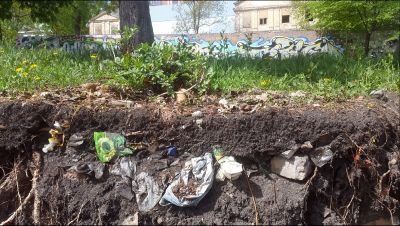| Line 27: | Line 27: | ||
==Students== | ==Students== | ||
*[[GMU:Humus-Micro-Habitats/Maximilian_Goetz| | *[[GMU:Humus-Micro-Habitats/Maximilian_Goetz|Maximilian Goetz]] | ||
*[[GMU:Humus-Micro-Habitats/Maximilian_Goetz|Maximilian_Goetz]] | *[[GMU:Humus-Micro-Habitats/Maximilian_Goetz|Maximilian_Goetz]] | ||
*[[GMU:Humus-Micro-Habitats/Maximilian_Goetz|Maximilian_Goetz]] | *[[GMU:Humus-Micro-Habitats/Maximilian_Goetz|Maximilian_Goetz]] | ||
Revision as of 13:51, 9 October 2019
Lecturer: Julian Chollet
Dates:
04.11. – 08.11.2019 (10:00 – 17:00)
Every day from 10-12 coffee discussions - OPEN for EVERYONE (Room 204)
Venue: Marienstraße 7b, DIY BioLab (Room 202)
THIS IS THE WIKI FOR THE COURSES IN SS 2019
Syllabus
Our air, soil and water as well as all plants and animals contain complex ecosystems.
This course will introduce you to various creatures colonizing the ground beneath our feet and give you the opportunity to experience methodologies and experimental strategies that are used in the natural sciences. While working in the DIY BioLab (Chair of Media Environments) you will learn how to think like a microbiologist and what it means to do scientific research. Educational objectives include literature research, experiment design, result documentation, discussion and scientific writing.
The module will be structured in a flexible way, tailored to the needs of the participants and includes lectures as well as practical work in the laboratory. Attendance during the 5 days of the course, as well as the delivery of detailed project documentation (paper, artwork, etc.) until the end of the semester is required.
The 5 day intensive course is integrated into the wider concept of the project module GMU:MfA_Masterproject_Soil–Humus–EarthxSoil-Humus-Earth (Prof. Ursula Damm) as well as the module Raised Beds and Pets (Mindaugas Gapsevicius).
Students
Projects
- ...
Basic concepts
Life
"There are over a 100 definitions for 'life' and all are wrong"
http://www.bbc.com/earth/story/20170101-there-are-over-100-definitions-for-life-and-all-are-wrong
https://en.wikipedia.org/wiki/Life#Definitions
Since there is no unequivocal definition of life, most current definitions in biology are descriptive. Life is considered a characteristic of something that preserves, furthers or reinforces its existence in the given environment. This characteristic exhibits all or most of the following traits:
Homeostasis Organization Metabolism Growth Adaptation Response to stimuli Reproduction
Organism
https://en.wikipedia.org/wiki/Organism
In biology, an organism (from Greek: ὀργανισμός, organismos) is any individual entity that exhibits the properties of life. It is a synonym for "life form".
Organisms are classified by taxonomy into specified groups such as the multicellular animals, plants, and fungi; or unicellular microorganisms such as a protists, bacteria, and archaea. All types of organisms are capable of reproduction, growth and development, maintenance, and some degree of response to stimuli.
Prokaryote
Prokaryotes are represented by two separate domains—bacteria and archaea. A unicellular organism that lacks a membrane-bound nucleus, mitochondria, or any other membrane-bound organelle.
Eukaryote
Eukaryotic organisms are characterized by the presence of a membrane-bound cell nucleus and contain additional membrane-bound compartments called organelles (such as mitochondria in animals and plants and plastids in plants and algae, all generally considered to be derived from endosymbiotic bacteria). Fungi, animals and plants are examples of kingdoms of organisms within the eukaryotes.
Microorganism
Living beings that are too small to be seen with the (human) eye.
https://en.wikipedia.org/wiki/Microorganism
https://en.wikipedia.org/wiki/Human_interactions_with_microbes
They live in almost every habitat from the poles to the equator, deserts, geysers, rocks and the deep sea. Some are adapted to extremes such as very hot or very cold conditions, others to high pressure or [...] high radiation environments. Microorganisms also make up the microbiota found in and on all multicellular organisms.
Microbes are important in human culture and health in many ways, serving to ferment foods, treat sewage, produce fuel, enzymes and other bioactive compounds. They are essential tools in biology as model organisms and have been put to use in biological warfare and bioterrorism. They are a vital component of fertile soils. In the human body microorganisms make up the human microbiota including the essential gut flora. They are the pathogens responsible for many infectious diseases and as such are the target of hygiene measures.
The possible existence of unseen microbial life was suspected from ancient times, such as in Jain scriptures from 6th century BC India and the 1st century BC book On Agriculture by Marcus Terentius Varro. Microbiology, the scientific study of microorganisms, began with their observation under the microscope in the 1670s by Antonie van Leeuwenhoek.
Cell biology / Molecular biology
https://en.wikipedia.org/wiki/Cell_biology
https://en.wikipedia.org/wiki/Molecular_biology
Cells consist of cytoplasm enclosed within a membrane, which contains many biomolecules such as proteins and nucleic acids.
A prokaryotic cell has three architectural regions:
1) Enclosing the cell is the cell envelope
2) Inside the cell is the cytoplasmic region that contains the genome (DNA), ribosomes and various sorts of inclusions.
3) On the outside, flagella and pili project from the cell's surface. These are structures (not present in all prokaryotes) made of proteins that facilitate movement and communication between cells.
Eukariotic cell The main distinguishing feature of eukaryotes as compared to prokaryotes is compartmentalization: the presence of membrane-bound organelles (compartments) in which specific activities take place.
Most important among these is a cell nucleus - an organelle that houses the cell's DNA. This nucleus gives the eukaryote its name, which means "true kernel (nucleus)".
Suggested resources regarding the proposed projects/topics
Chitosan from microbes
- https://application.wiley-vch.de/books/biopoly/pdf_v06/bpol6005_123_132.pdf
- http://www.imedpub.com/articles/fermentative-production-of-fungal-chitosan-a-versatile-biopolymerperspectives-and-its-applications.pdf
- https://onlinelibrary.wiley.com/doi/full/10.1046/j.1472-765X.2002.01118.x
- http://espace.inrs.ca/3898/1/P2940_PP.pdf
- https://www.researchgate.net/publication/314121703_MICROBIAL_EXTRACTION_OF_CHITIN_AND_CHITOSAN_FROM_PLEUROTUS_SPP_ITS_CHARACTERIZATION_AND_ANTIMICROBIAL_ACTIVITY
Microbial photography
Related Projects from the DIY Biolab @Bauhaus
- Bio.match
- PhyChip synthesiser
- GMU:Habitats_SS18
- GMU:BioArt_WS15/Physarum_polycephalum_and_unconventional_computing
please add projects!! :)
